Taxation Law Assignment: Fringe Benefits, Capital Gains Tax Analysis
VerifiedAdded on 2020/05/16
|9
|2892
|105
Homework Assignment
AI Summary
This taxation law assignment explores two main areas: fringe benefits tax (FBT) and capital gains tax (CGT). The first part analyzes whether providing a car to an employee constitutes a fringe benefit under the Fringe Benefit Tax Assessment Act 1986 (FBTAA 1986). It examines the relevant rules, including the definitions of fringe benefits, car fringe benefits, and the application of statutory and cost basis formulas for calculating the taxable value. The assignment applies these rules to a case study involving an employer providing a car for an employee's private use, concluding that the employer is liable for car fringe benefit tax. The second part delves into capital gains tax, integrating it into income tax regimes. It examines the CGT implications of various asset sales, including a residential property, an artistic painting, a luxury yacht (personal use asset), and shares. The analysis considers relevant sections of the Income Tax Assessment Act 1997 (ITAA 1997), such as CGT event H1, collectables, and personal use assets. The assignment concludes by summarizing the capital gains that can be used to fund retirement and the treatment of capital losses from personal-use assets. The document provides a comprehensive overview of both FBT and CGT, offering practical application of tax law principles.
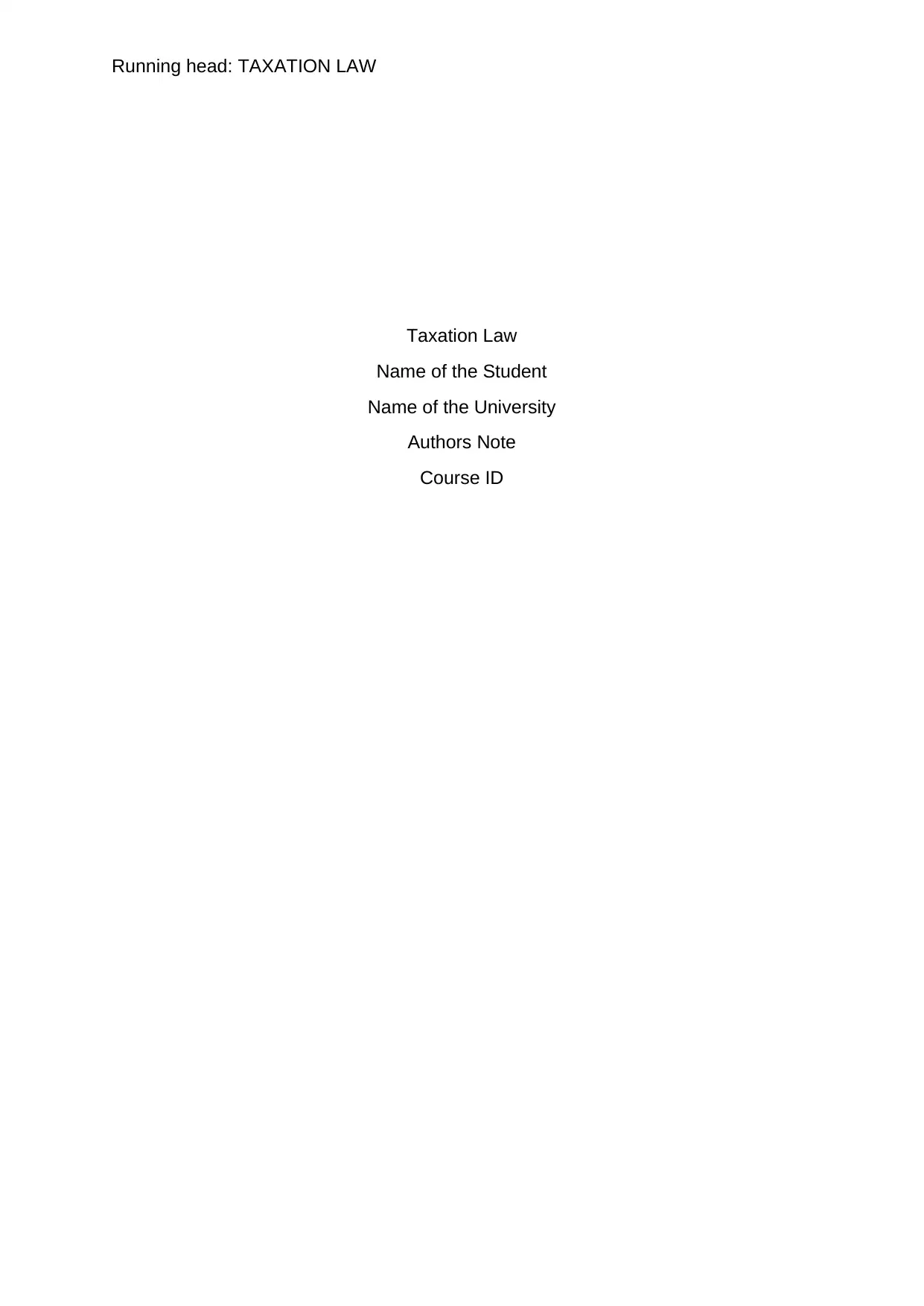
Running head: TAXATION LAW
Taxation Law
Name of the Student
Name of the University
Authors Note
Course ID
Taxation Law
Name of the Student
Name of the University
Authors Note
Course ID
Paraphrase This Document
Need a fresh take? Get an instant paraphrase of this document with our AI Paraphraser
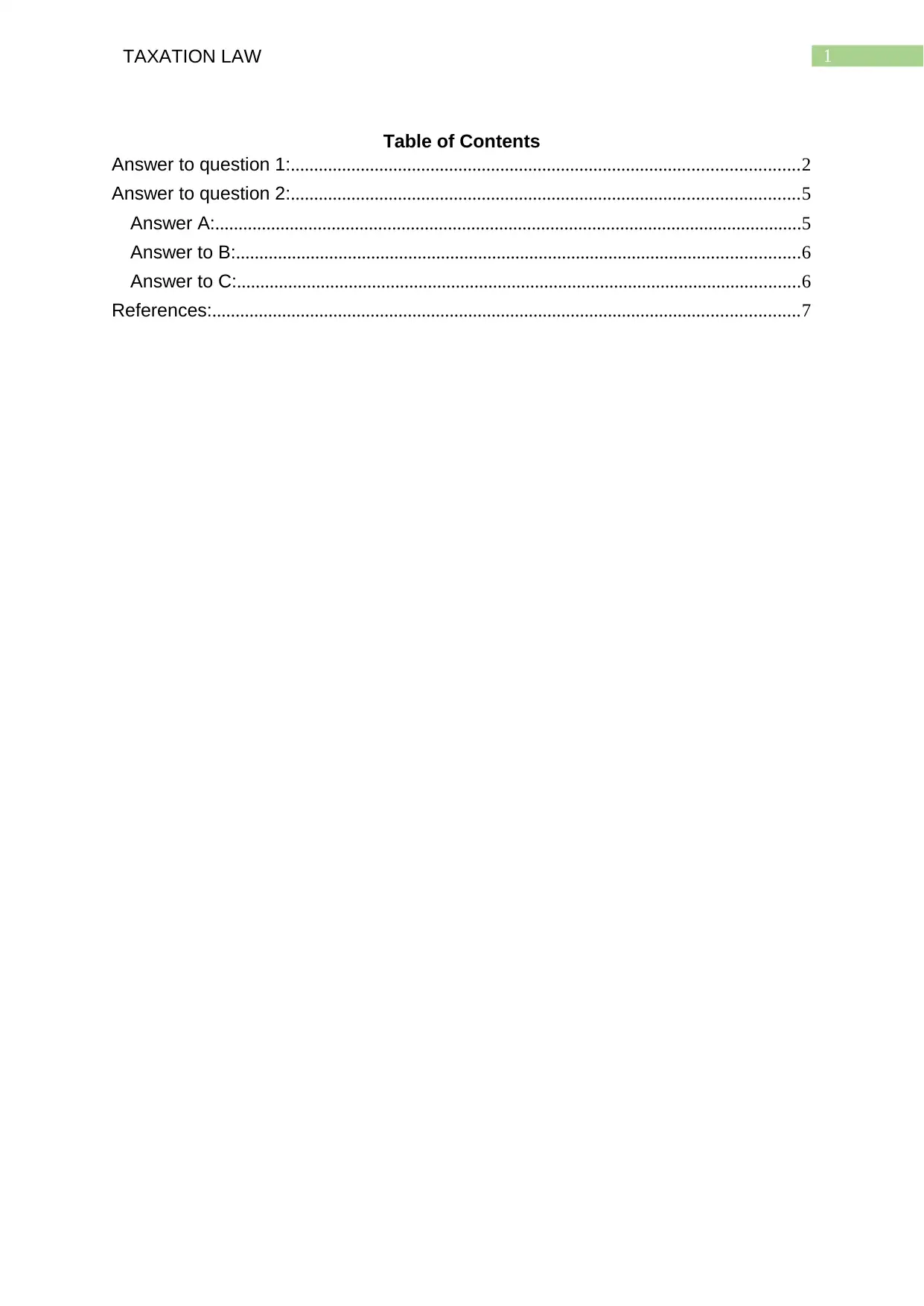
1TAXATION LAW
Table of Contents
Answer to question 1:.............................................................................................................2
Answer to question 2:.............................................................................................................5
Answer A:..............................................................................................................................5
Answer to B:.........................................................................................................................6
Answer to C:.........................................................................................................................6
References:..............................................................................................................................7
Table of Contents
Answer to question 1:.............................................................................................................2
Answer to question 2:.............................................................................................................5
Answer A:..............................................................................................................................5
Answer to B:.........................................................................................................................6
Answer to C:.........................................................................................................................6
References:..............................................................................................................................7
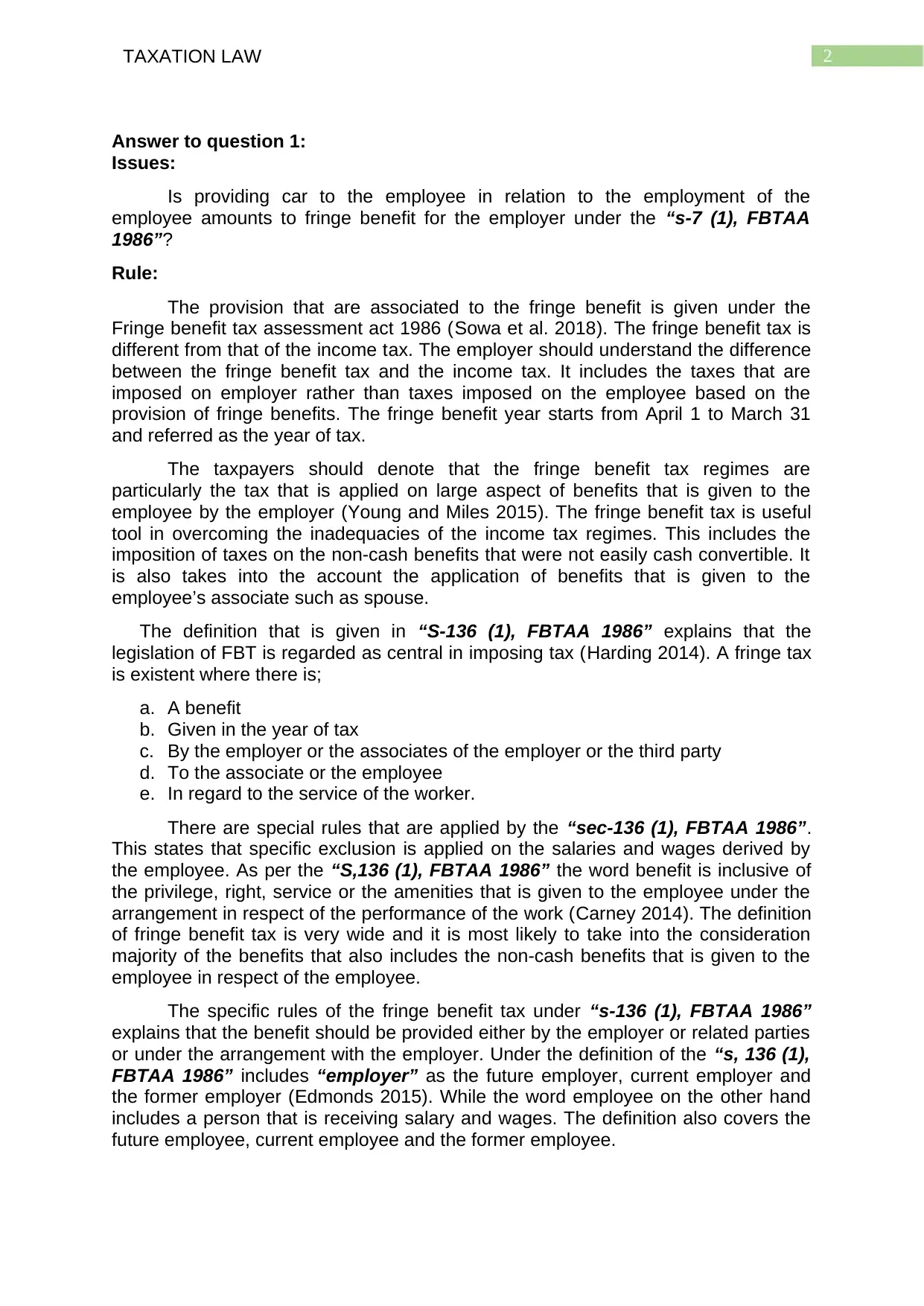
2TAXATION LAW
Answer to question 1:
Issues:
Is providing car to the employee in relation to the employment of the
employee amounts to fringe benefit for the employer under the “s-7 (1), FBTAA
1986”?
Rule:
The provision that are associated to the fringe benefit is given under the
Fringe benefit tax assessment act 1986 (Sowa et al. 2018). The fringe benefit tax is
different from that of the income tax. The employer should understand the difference
between the fringe benefit tax and the income tax. It includes the taxes that are
imposed on employer rather than taxes imposed on the employee based on the
provision of fringe benefits. The fringe benefit year starts from April 1 to March 31
and referred as the year of tax.
The taxpayers should denote that the fringe benefit tax regimes are
particularly the tax that is applied on large aspect of benefits that is given to the
employee by the employer (Young and Miles 2015). The fringe benefit tax is useful
tool in overcoming the inadequacies of the income tax regimes. This includes the
imposition of taxes on the non-cash benefits that were not easily cash convertible. It
is also takes into the account the application of benefits that is given to the
employee’s associate such as spouse.
The definition that is given in “S-136 (1), FBTAA 1986” explains that the
legislation of FBT is regarded as central in imposing tax (Harding 2014). A fringe tax
is existent where there is;
a. A benefit
b. Given in the year of tax
c. By the employer or the associates of the employer or the third party
d. To the associate or the employee
e. In regard to the service of the worker.
There are special rules that are applied by the “sec-136 (1), FBTAA 1986”.
This states that specific exclusion is applied on the salaries and wages derived by
the employee. As per the “S,136 (1), FBTAA 1986” the word benefit is inclusive of
the privilege, right, service or the amenities that is given to the employee under the
arrangement in respect of the performance of the work (Carney 2014). The definition
of fringe benefit tax is very wide and it is most likely to take into the consideration
majority of the benefits that also includes the non-cash benefits that is given to the
employee in respect of the employee.
The specific rules of the fringe benefit tax under “s-136 (1), FBTAA 1986”
explains that the benefit should be provided either by the employer or related parties
or under the arrangement with the employer. Under the definition of the “s, 136 (1),
FBTAA 1986” includes “employer” as the future employer, current employer and
the former employer (Edmonds 2015). While the word employee on the other hand
includes a person that is receiving salary and wages. The definition also covers the
future employee, current employee and the former employee.
Answer to question 1:
Issues:
Is providing car to the employee in relation to the employment of the
employee amounts to fringe benefit for the employer under the “s-7 (1), FBTAA
1986”?
Rule:
The provision that are associated to the fringe benefit is given under the
Fringe benefit tax assessment act 1986 (Sowa et al. 2018). The fringe benefit tax is
different from that of the income tax. The employer should understand the difference
between the fringe benefit tax and the income tax. It includes the taxes that are
imposed on employer rather than taxes imposed on the employee based on the
provision of fringe benefits. The fringe benefit year starts from April 1 to March 31
and referred as the year of tax.
The taxpayers should denote that the fringe benefit tax regimes are
particularly the tax that is applied on large aspect of benefits that is given to the
employee by the employer (Young and Miles 2015). The fringe benefit tax is useful
tool in overcoming the inadequacies of the income tax regimes. This includes the
imposition of taxes on the non-cash benefits that were not easily cash convertible. It
is also takes into the account the application of benefits that is given to the
employee’s associate such as spouse.
The definition that is given in “S-136 (1), FBTAA 1986” explains that the
legislation of FBT is regarded as central in imposing tax (Harding 2014). A fringe tax
is existent where there is;
a. A benefit
b. Given in the year of tax
c. By the employer or the associates of the employer or the third party
d. To the associate or the employee
e. In regard to the service of the worker.
There are special rules that are applied by the “sec-136 (1), FBTAA 1986”.
This states that specific exclusion is applied on the salaries and wages derived by
the employee. As per the “S,136 (1), FBTAA 1986” the word benefit is inclusive of
the privilege, right, service or the amenities that is given to the employee under the
arrangement in respect of the performance of the work (Carney 2014). The definition
of fringe benefit tax is very wide and it is most likely to take into the consideration
majority of the benefits that also includes the non-cash benefits that is given to the
employee in respect of the employee.
The specific rules of the fringe benefit tax under “s-136 (1), FBTAA 1986”
explains that the benefit should be provided either by the employer or related parties
or under the arrangement with the employer. Under the definition of the “s, 136 (1),
FBTAA 1986” includes “employer” as the future employer, current employer and
the former employer (Edmonds 2015). While the word employee on the other hand
includes a person that is receiving salary and wages. The definition also covers the
future employee, current employee and the former employee.
⊘ This is a preview!⊘
Do you want full access?
Subscribe today to unlock all pages.

Trusted by 1+ million students worldwide
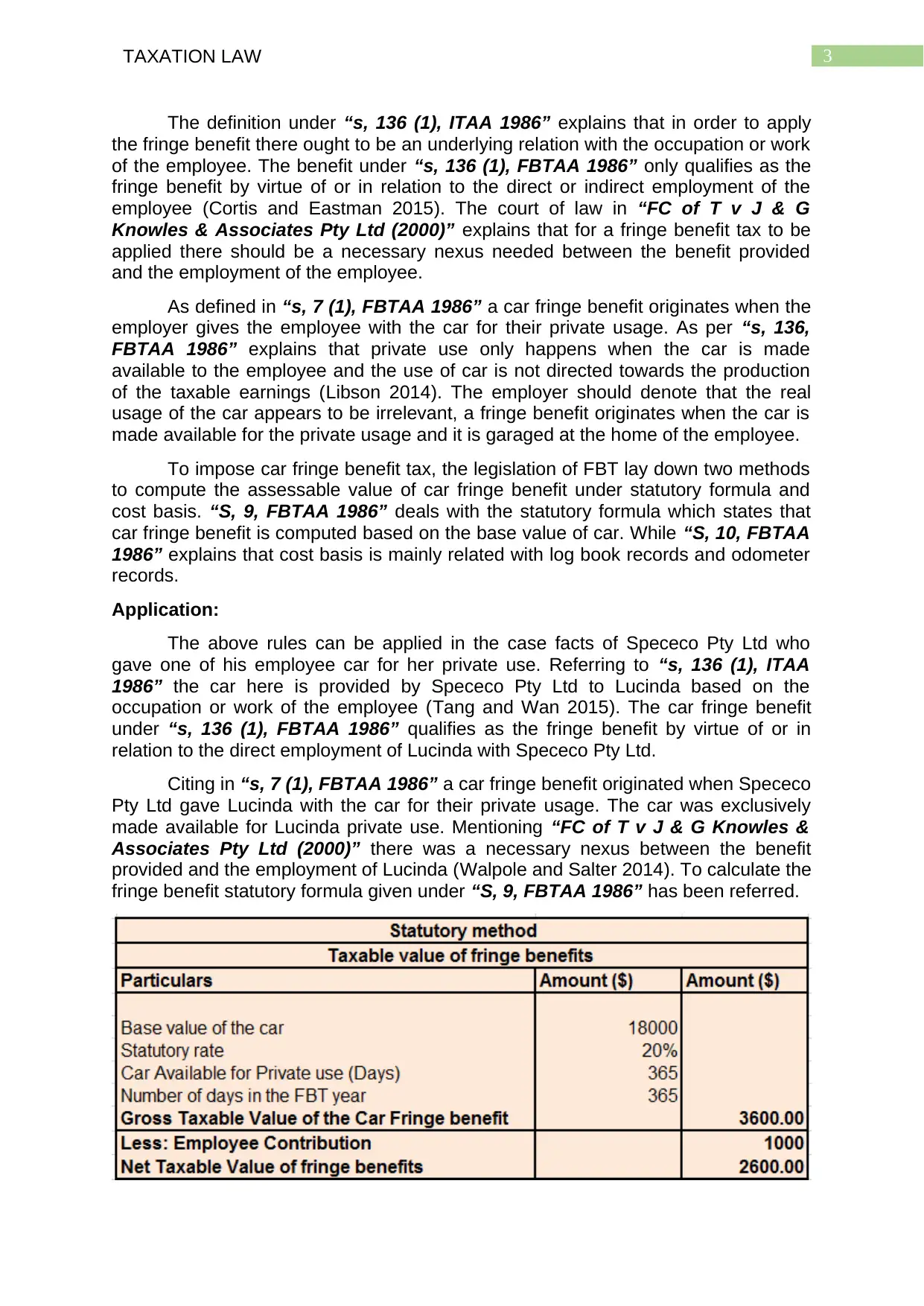
3TAXATION LAW
The definition under “s, 136 (1), ITAA 1986” explains that in order to apply
the fringe benefit there ought to be an underlying relation with the occupation or work
of the employee. The benefit under “s, 136 (1), FBTAA 1986” only qualifies as the
fringe benefit by virtue of or in relation to the direct or indirect employment of the
employee (Cortis and Eastman 2015). The court of law in “FC of T v J & G
Knowles & Associates Pty Ltd (2000)” explains that for a fringe benefit tax to be
applied there should be a necessary nexus needed between the benefit provided
and the employment of the employee.
As defined in “s, 7 (1), FBTAA 1986” a car fringe benefit originates when the
employer gives the employee with the car for their private usage. As per “s, 136,
FBTAA 1986” explains that private use only happens when the car is made
available to the employee and the use of car is not directed towards the production
of the taxable earnings (Libson 2014). The employer should denote that the real
usage of the car appears to be irrelevant, a fringe benefit originates when the car is
made available for the private usage and it is garaged at the home of the employee.
To impose car fringe benefit tax, the legislation of FBT lay down two methods
to compute the assessable value of car fringe benefit under statutory formula and
cost basis. “S, 9, FBTAA 1986” deals with the statutory formula which states that
car fringe benefit is computed based on the base value of car. While “S, 10, FBTAA
1986” explains that cost basis is mainly related with log book records and odometer
records.
Application:
The above rules can be applied in the case facts of Spececo Pty Ltd who
gave one of his employee car for her private use. Referring to “s, 136 (1), ITAA
1986” the car here is provided by Spececo Pty Ltd to Lucinda based on the
occupation or work of the employee (Tang and Wan 2015). The car fringe benefit
under “s, 136 (1), FBTAA 1986” qualifies as the fringe benefit by virtue of or in
relation to the direct employment of Lucinda with Spececo Pty Ltd.
Citing in “s, 7 (1), FBTAA 1986” a car fringe benefit originated when Spececo
Pty Ltd gave Lucinda with the car for their private usage. The car was exclusively
made available for Lucinda private use. Mentioning “FC of T v J & G Knowles &
Associates Pty Ltd (2000)” there was a necessary nexus between the benefit
provided and the employment of Lucinda (Walpole and Salter 2014). To calculate the
fringe benefit statutory formula given under “S, 9, FBTAA 1986” has been referred.
The definition under “s, 136 (1), ITAA 1986” explains that in order to apply
the fringe benefit there ought to be an underlying relation with the occupation or work
of the employee. The benefit under “s, 136 (1), FBTAA 1986” only qualifies as the
fringe benefit by virtue of or in relation to the direct or indirect employment of the
employee (Cortis and Eastman 2015). The court of law in “FC of T v J & G
Knowles & Associates Pty Ltd (2000)” explains that for a fringe benefit tax to be
applied there should be a necessary nexus needed between the benefit provided
and the employment of the employee.
As defined in “s, 7 (1), FBTAA 1986” a car fringe benefit originates when the
employer gives the employee with the car for their private usage. As per “s, 136,
FBTAA 1986” explains that private use only happens when the car is made
available to the employee and the use of car is not directed towards the production
of the taxable earnings (Libson 2014). The employer should denote that the real
usage of the car appears to be irrelevant, a fringe benefit originates when the car is
made available for the private usage and it is garaged at the home of the employee.
To impose car fringe benefit tax, the legislation of FBT lay down two methods
to compute the assessable value of car fringe benefit under statutory formula and
cost basis. “S, 9, FBTAA 1986” deals with the statutory formula which states that
car fringe benefit is computed based on the base value of car. While “S, 10, FBTAA
1986” explains that cost basis is mainly related with log book records and odometer
records.
Application:
The above rules can be applied in the case facts of Spececo Pty Ltd who
gave one of his employee car for her private use. Referring to “s, 136 (1), ITAA
1986” the car here is provided by Spececo Pty Ltd to Lucinda based on the
occupation or work of the employee (Tang and Wan 2015). The car fringe benefit
under “s, 136 (1), FBTAA 1986” qualifies as the fringe benefit by virtue of or in
relation to the direct employment of Lucinda with Spececo Pty Ltd.
Citing in “s, 7 (1), FBTAA 1986” a car fringe benefit originated when Spececo
Pty Ltd gave Lucinda with the car for their private usage. The car was exclusively
made available for Lucinda private use. Mentioning “FC of T v J & G Knowles &
Associates Pty Ltd (2000)” there was a necessary nexus between the benefit
provided and the employment of Lucinda (Walpole and Salter 2014). To calculate the
fringe benefit statutory formula given under “S, 9, FBTAA 1986” has been referred.
Paraphrase This Document
Need a fresh take? Get an instant paraphrase of this document with our AI Paraphraser
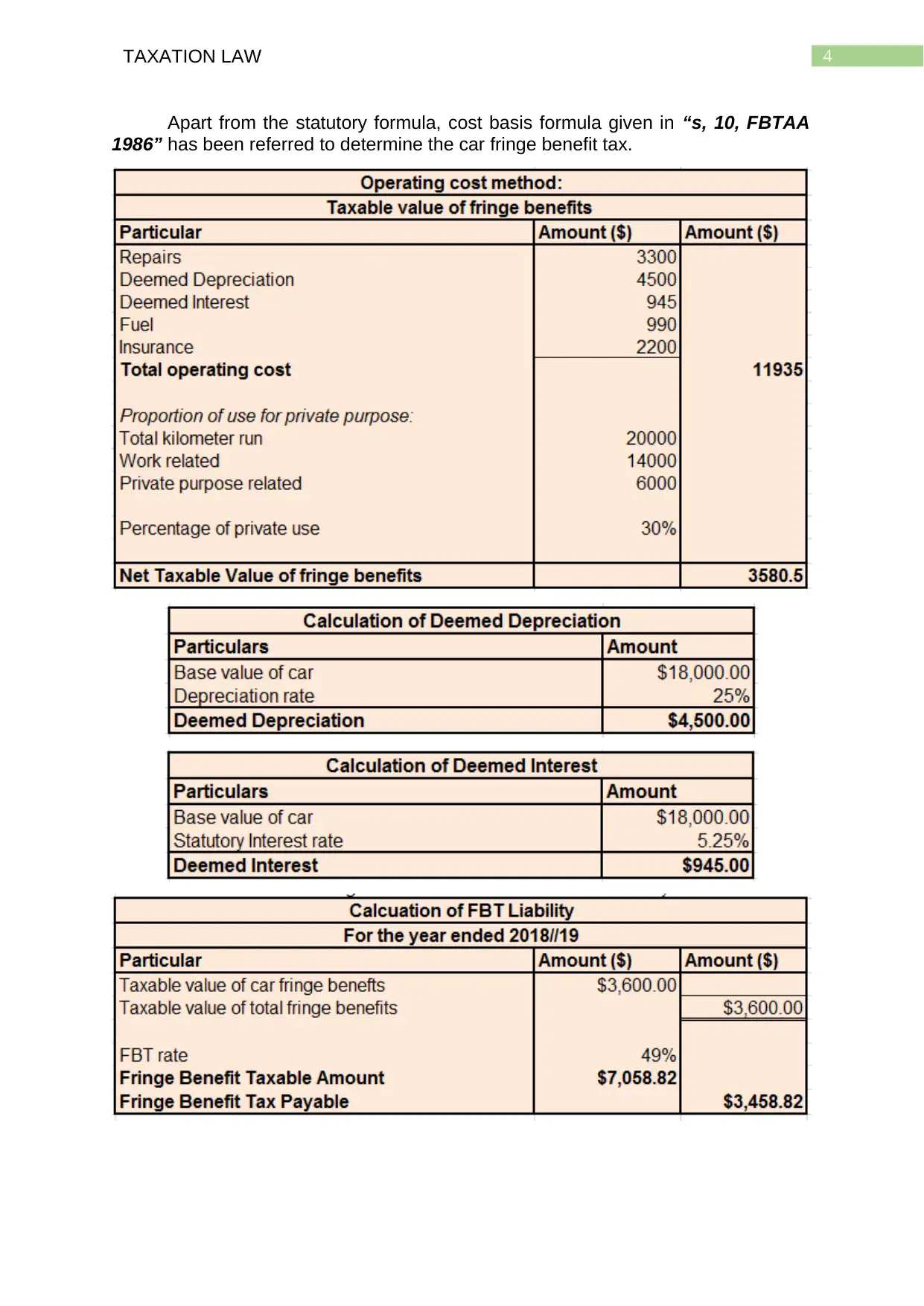
4TAXATION LAW
Apart from the statutory formula, cost basis formula given in “s, 10, FBTAA
1986” has been referred to determine the car fringe benefit tax.
Apart from the statutory formula, cost basis formula given in “s, 10, FBTAA
1986” has been referred to determine the car fringe benefit tax.
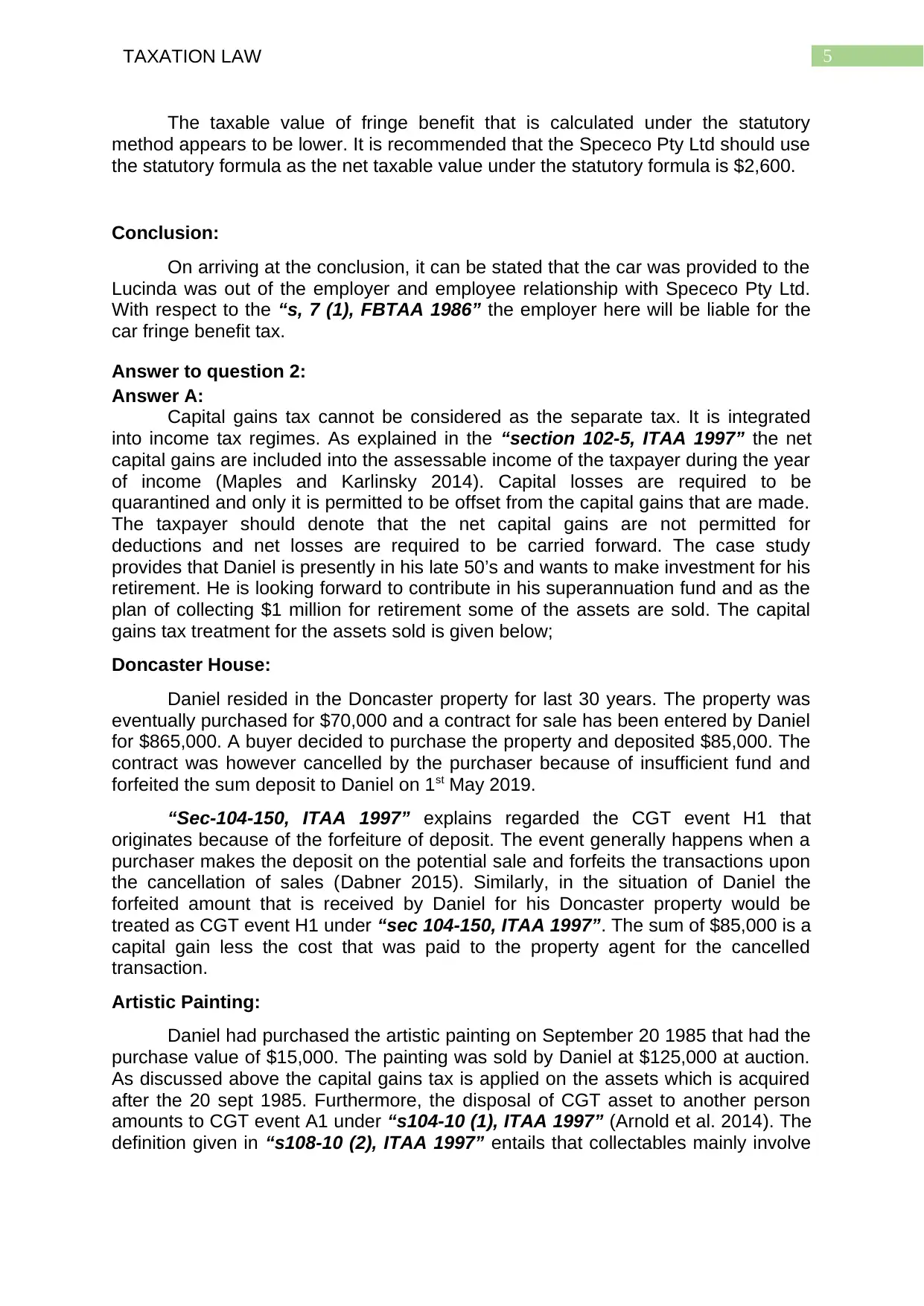
5TAXATION LAW
The taxable value of fringe benefit that is calculated under the statutory
method appears to be lower. It is recommended that the Spececo Pty Ltd should use
the statutory formula as the net taxable value under the statutory formula is $2,600.
Conclusion:
On arriving at the conclusion, it can be stated that the car was provided to the
Lucinda was out of the employer and employee relationship with Spececo Pty Ltd.
With respect to the “s, 7 (1), FBTAA 1986” the employer here will be liable for the
car fringe benefit tax.
Answer to question 2:
Answer A:
Capital gains tax cannot be considered as the separate tax. It is integrated
into income tax regimes. As explained in the “section 102-5, ITAA 1997” the net
capital gains are included into the assessable income of the taxpayer during the year
of income (Maples and Karlinsky 2014). Capital losses are required to be
quarantined and only it is permitted to be offset from the capital gains that are made.
The taxpayer should denote that the net capital gains are not permitted for
deductions and net losses are required to be carried forward. The case study
provides that Daniel is presently in his late 50’s and wants to make investment for his
retirement. He is looking forward to contribute in his superannuation fund and as the
plan of collecting $1 million for retirement some of the assets are sold. The capital
gains tax treatment for the assets sold is given below;
Doncaster House:
Daniel resided in the Doncaster property for last 30 years. The property was
eventually purchased for $70,000 and a contract for sale has been entered by Daniel
for $865,000. A buyer decided to purchase the property and deposited $85,000. The
contract was however cancelled by the purchaser because of insufficient fund and
forfeited the sum deposit to Daniel on 1st May 2019.
“Sec-104-150, ITAA 1997” explains regarded the CGT event H1 that
originates because of the forfeiture of deposit. The event generally happens when a
purchaser makes the deposit on the potential sale and forfeits the transactions upon
the cancellation of sales (Dabner 2015). Similarly, in the situation of Daniel the
forfeited amount that is received by Daniel for his Doncaster property would be
treated as CGT event H1 under “sec 104-150, ITAA 1997”. The sum of $85,000 is a
capital gain less the cost that was paid to the property agent for the cancelled
transaction.
Artistic Painting:
Daniel had purchased the artistic painting on September 20 1985 that had the
purchase value of $15,000. The painting was sold by Daniel at $125,000 at auction.
As discussed above the capital gains tax is applied on the assets which is acquired
after the 20 sept 1985. Furthermore, the disposal of CGT asset to another person
amounts to CGT event A1 under “s104-10 (1), ITAA 1997” (Arnold et al. 2014). The
definition given in “s108-10 (2), ITAA 1997” entails that collectables mainly involve
The taxable value of fringe benefit that is calculated under the statutory
method appears to be lower. It is recommended that the Spececo Pty Ltd should use
the statutory formula as the net taxable value under the statutory formula is $2,600.
Conclusion:
On arriving at the conclusion, it can be stated that the car was provided to the
Lucinda was out of the employer and employee relationship with Spececo Pty Ltd.
With respect to the “s, 7 (1), FBTAA 1986” the employer here will be liable for the
car fringe benefit tax.
Answer to question 2:
Answer A:
Capital gains tax cannot be considered as the separate tax. It is integrated
into income tax regimes. As explained in the “section 102-5, ITAA 1997” the net
capital gains are included into the assessable income of the taxpayer during the year
of income (Maples and Karlinsky 2014). Capital losses are required to be
quarantined and only it is permitted to be offset from the capital gains that are made.
The taxpayer should denote that the net capital gains are not permitted for
deductions and net losses are required to be carried forward. The case study
provides that Daniel is presently in his late 50’s and wants to make investment for his
retirement. He is looking forward to contribute in his superannuation fund and as the
plan of collecting $1 million for retirement some of the assets are sold. The capital
gains tax treatment for the assets sold is given below;
Doncaster House:
Daniel resided in the Doncaster property for last 30 years. The property was
eventually purchased for $70,000 and a contract for sale has been entered by Daniel
for $865,000. A buyer decided to purchase the property and deposited $85,000. The
contract was however cancelled by the purchaser because of insufficient fund and
forfeited the sum deposit to Daniel on 1st May 2019.
“Sec-104-150, ITAA 1997” explains regarded the CGT event H1 that
originates because of the forfeiture of deposit. The event generally happens when a
purchaser makes the deposit on the potential sale and forfeits the transactions upon
the cancellation of sales (Dabner 2015). Similarly, in the situation of Daniel the
forfeited amount that is received by Daniel for his Doncaster property would be
treated as CGT event H1 under “sec 104-150, ITAA 1997”. The sum of $85,000 is a
capital gain less the cost that was paid to the property agent for the cancelled
transaction.
Artistic Painting:
Daniel had purchased the artistic painting on September 20 1985 that had the
purchase value of $15,000. The painting was sold by Daniel at $125,000 at auction.
As discussed above the capital gains tax is applied on the assets which is acquired
after the 20 sept 1985. Furthermore, the disposal of CGT asset to another person
amounts to CGT event A1 under “s104-10 (1), ITAA 1997” (Arnold et al. 2014). The
definition given in “s108-10 (2), ITAA 1997” entails that collectables mainly involve
⊘ This is a preview!⊘
Do you want full access?
Subscribe today to unlock all pages.

Trusted by 1+ million students worldwide
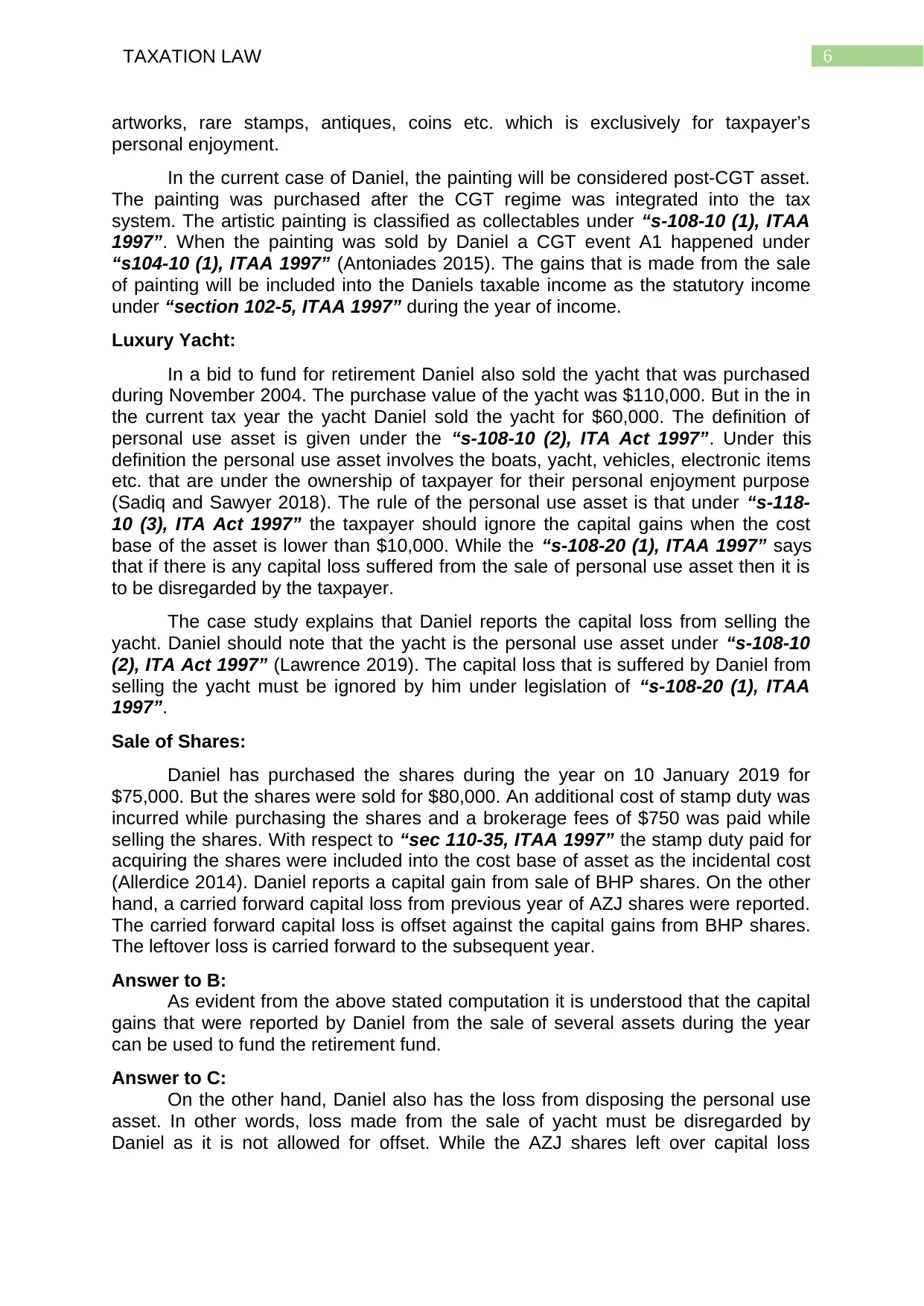
6TAXATION LAW
artworks, rare stamps, antiques, coins etc. which is exclusively for taxpayer’s
personal enjoyment.
In the current case of Daniel, the painting will be considered post-CGT asset.
The painting was purchased after the CGT regime was integrated into the tax
system. The artistic painting is classified as collectables under “s-108-10 (1), ITAA
1997”. When the painting was sold by Daniel a CGT event A1 happened under
“s104-10 (1), ITAA 1997” (Antoniades 2015). The gains that is made from the sale
of painting will be included into the Daniels taxable income as the statutory income
under “section 102-5, ITAA 1997” during the year of income.
Luxury Yacht:
In a bid to fund for retirement Daniel also sold the yacht that was purchased
during November 2004. The purchase value of the yacht was $110,000. But in the in
the current tax year the yacht Daniel sold the yacht for $60,000. The definition of
personal use asset is given under the “s-108-10 (2), ITA Act 1997”. Under this
definition the personal use asset involves the boats, yacht, vehicles, electronic items
etc. that are under the ownership of taxpayer for their personal enjoyment purpose
(Sadiq and Sawyer 2018). The rule of the personal use asset is that under “s-118-
10 (3), ITA Act 1997” the taxpayer should ignore the capital gains when the cost
base of the asset is lower than $10,000. While the “s-108-20 (1), ITAA 1997” says
that if there is any capital loss suffered from the sale of personal use asset then it is
to be disregarded by the taxpayer.
The case study explains that Daniel reports the capital loss from selling the
yacht. Daniel should note that the yacht is the personal use asset under “s-108-10
(2), ITA Act 1997” (Lawrence 2019). The capital loss that is suffered by Daniel from
selling the yacht must be ignored by him under legislation of “s-108-20 (1), ITAA
1997”.
Sale of Shares:
Daniel has purchased the shares during the year on 10 January 2019 for
$75,000. But the shares were sold for $80,000. An additional cost of stamp duty was
incurred while purchasing the shares and a brokerage fees of $750 was paid while
selling the shares. With respect to “sec 110-35, ITAA 1997” the stamp duty paid for
acquiring the shares were included into the cost base of asset as the incidental cost
(Allerdice 2014). Daniel reports a capital gain from sale of BHP shares. On the other
hand, a carried forward capital loss from previous year of AZJ shares were reported.
The carried forward capital loss is offset against the capital gains from BHP shares.
The leftover loss is carried forward to the subsequent year.
Answer to B:
As evident from the above stated computation it is understood that the capital
gains that were reported by Daniel from the sale of several assets during the year
can be used to fund the retirement fund.
Answer to C:
On the other hand, Daniel also has the loss from disposing the personal use
asset. In other words, loss made from the sale of yacht must be disregarded by
Daniel as it is not allowed for offset. While the AZJ shares left over capital loss
artworks, rare stamps, antiques, coins etc. which is exclusively for taxpayer’s
personal enjoyment.
In the current case of Daniel, the painting will be considered post-CGT asset.
The painting was purchased after the CGT regime was integrated into the tax
system. The artistic painting is classified as collectables under “s-108-10 (1), ITAA
1997”. When the painting was sold by Daniel a CGT event A1 happened under
“s104-10 (1), ITAA 1997” (Antoniades 2015). The gains that is made from the sale
of painting will be included into the Daniels taxable income as the statutory income
under “section 102-5, ITAA 1997” during the year of income.
Luxury Yacht:
In a bid to fund for retirement Daniel also sold the yacht that was purchased
during November 2004. The purchase value of the yacht was $110,000. But in the in
the current tax year the yacht Daniel sold the yacht for $60,000. The definition of
personal use asset is given under the “s-108-10 (2), ITA Act 1997”. Under this
definition the personal use asset involves the boats, yacht, vehicles, electronic items
etc. that are under the ownership of taxpayer for their personal enjoyment purpose
(Sadiq and Sawyer 2018). The rule of the personal use asset is that under “s-118-
10 (3), ITA Act 1997” the taxpayer should ignore the capital gains when the cost
base of the asset is lower than $10,000. While the “s-108-20 (1), ITAA 1997” says
that if there is any capital loss suffered from the sale of personal use asset then it is
to be disregarded by the taxpayer.
The case study explains that Daniel reports the capital loss from selling the
yacht. Daniel should note that the yacht is the personal use asset under “s-108-10
(2), ITA Act 1997” (Lawrence 2019). The capital loss that is suffered by Daniel from
selling the yacht must be ignored by him under legislation of “s-108-20 (1), ITAA
1997”.
Sale of Shares:
Daniel has purchased the shares during the year on 10 January 2019 for
$75,000. But the shares were sold for $80,000. An additional cost of stamp duty was
incurred while purchasing the shares and a brokerage fees of $750 was paid while
selling the shares. With respect to “sec 110-35, ITAA 1997” the stamp duty paid for
acquiring the shares were included into the cost base of asset as the incidental cost
(Allerdice 2014). Daniel reports a capital gain from sale of BHP shares. On the other
hand, a carried forward capital loss from previous year of AZJ shares were reported.
The carried forward capital loss is offset against the capital gains from BHP shares.
The leftover loss is carried forward to the subsequent year.
Answer to B:
As evident from the above stated computation it is understood that the capital
gains that were reported by Daniel from the sale of several assets during the year
can be used to fund the retirement fund.
Answer to C:
On the other hand, Daniel also has the loss from disposing the personal use
asset. In other words, loss made from the sale of yacht must be disregarded by
Daniel as it is not allowed for offset. While the AZJ shares left over capital loss
Paraphrase This Document
Need a fresh take? Get an instant paraphrase of this document with our AI Paraphraser
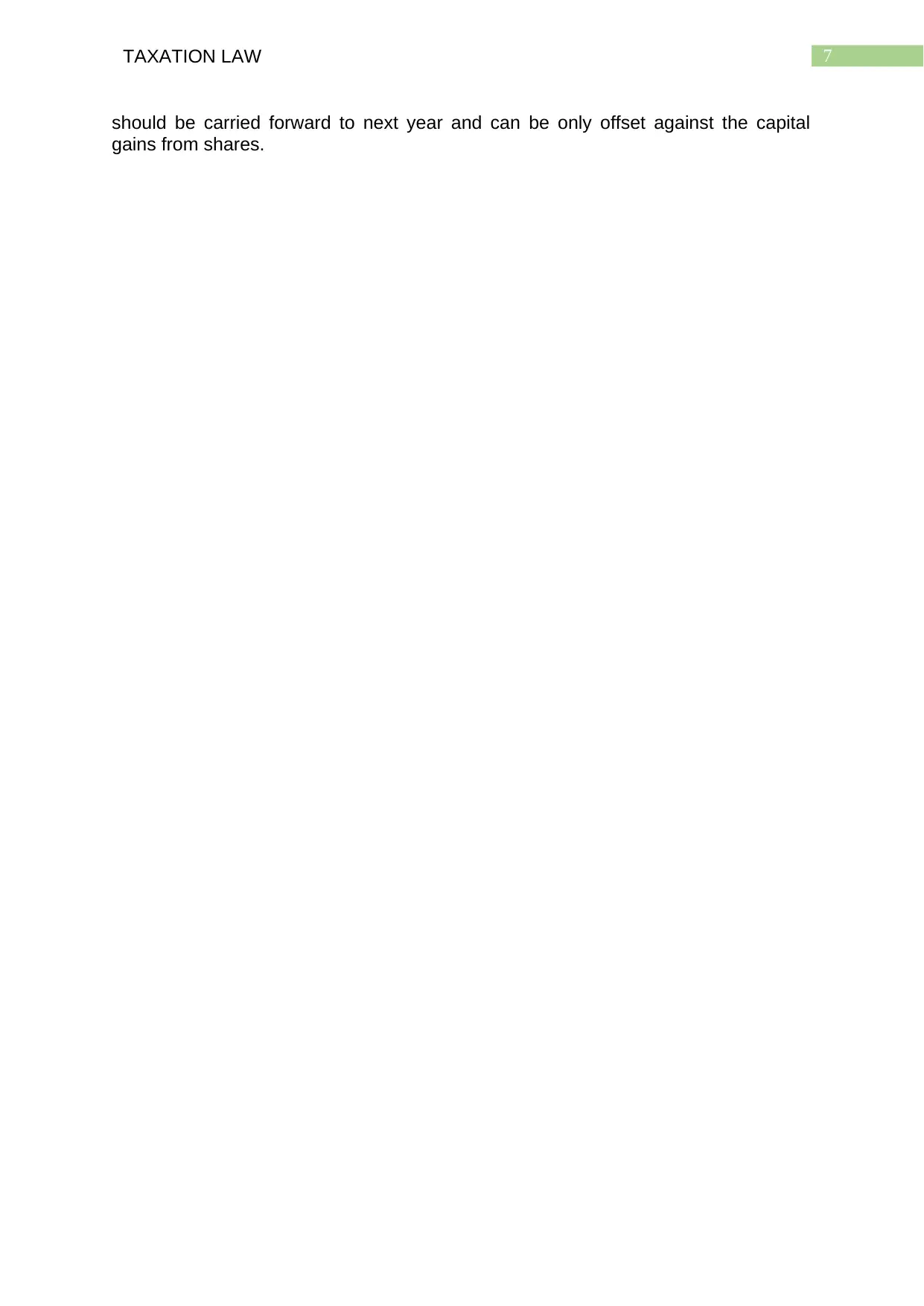
7TAXATION LAW
should be carried forward to next year and can be only offset against the capital
gains from shares.
should be carried forward to next year and can be only offset against the capital
gains from shares.
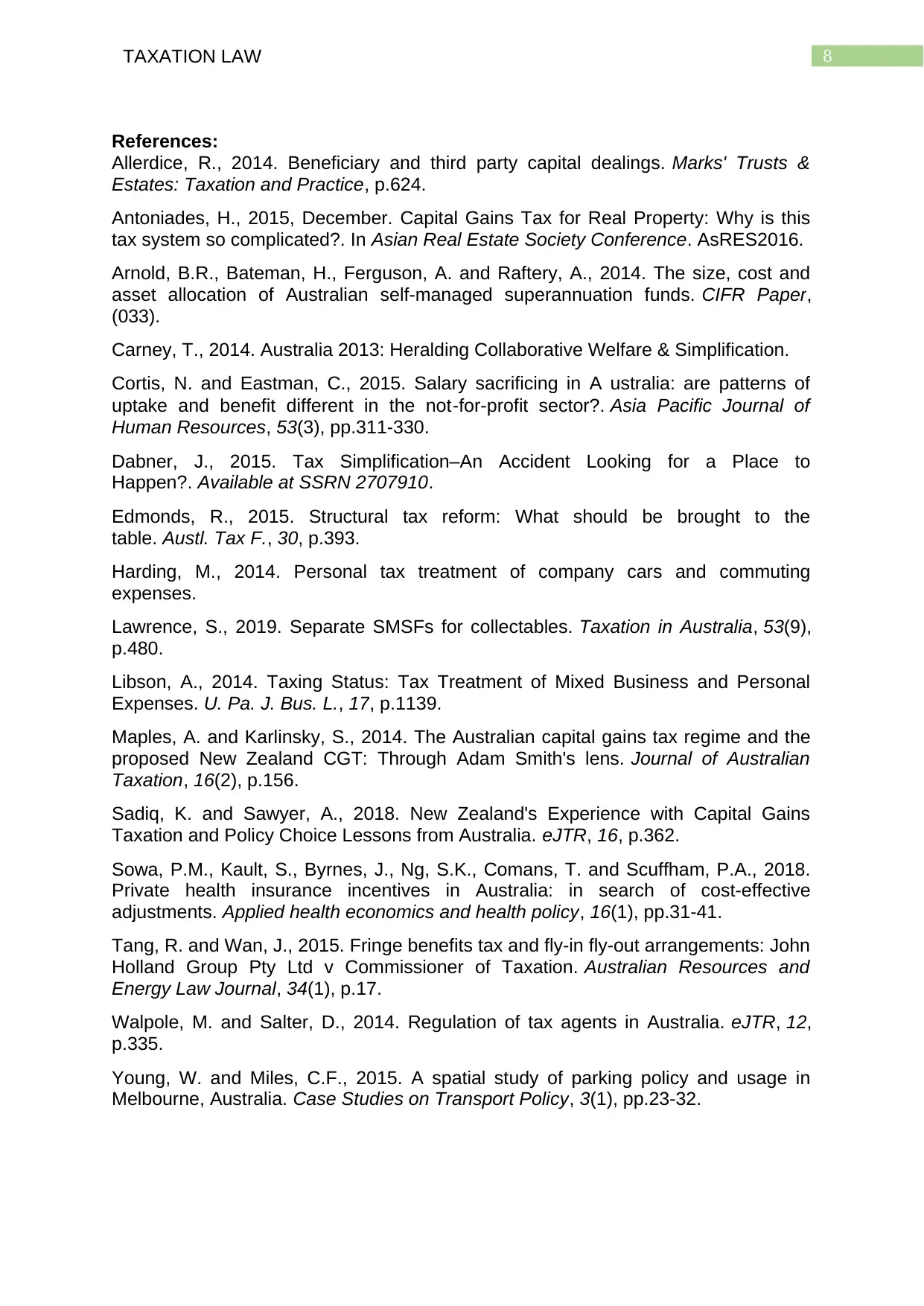
8TAXATION LAW
References:
Allerdice, R., 2014. Beneficiary and third party capital dealings. Marks' Trusts &
Estates: Taxation and Practice, p.624.
Antoniades, H., 2015, December. Capital Gains Tax for Real Property: Why is this
tax system so complicated?. In Asian Real Estate Society Conference. AsRES2016.
Arnold, B.R., Bateman, H., Ferguson, A. and Raftery, A., 2014. The size, cost and
asset allocation of Australian self-managed superannuation funds. CIFR Paper,
(033).
Carney, T., 2014. Australia 2013: Heralding Collaborative Welfare & Simplification.
Cortis, N. and Eastman, C., 2015. Salary sacrificing in A ustralia: are patterns of
uptake and benefit different in the not‐for‐profit sector?. Asia Pacific Journal of
Human Resources, 53(3), pp.311-330.
Dabner, J., 2015. Tax Simplification–An Accident Looking for a Place to
Happen?. Available at SSRN 2707910.
Edmonds, R., 2015. Structural tax reform: What should be brought to the
table. Austl. Tax F., 30, p.393.
Harding, M., 2014. Personal tax treatment of company cars and commuting
expenses.
Lawrence, S., 2019. Separate SMSFs for collectables. Taxation in Australia, 53(9),
p.480.
Libson, A., 2014. Taxing Status: Tax Treatment of Mixed Business and Personal
Expenses. U. Pa. J. Bus. L., 17, p.1139.
Maples, A. and Karlinsky, S., 2014. The Australian capital gains tax regime and the
proposed New Zealand CGT: Through Adam Smith's lens. Journal of Australian
Taxation, 16(2), p.156.
Sadiq, K. and Sawyer, A., 2018. New Zealand's Experience with Capital Gains
Taxation and Policy Choice Lessons from Australia. eJTR, 16, p.362.
Sowa, P.M., Kault, S., Byrnes, J., Ng, S.K., Comans, T. and Scuffham, P.A., 2018.
Private health insurance incentives in Australia: in search of cost-effective
adjustments. Applied health economics and health policy, 16(1), pp.31-41.
Tang, R. and Wan, J., 2015. Fringe benefits tax and fly-in fly-out arrangements: John
Holland Group Pty Ltd v Commissioner of Taxation. Australian Resources and
Energy Law Journal, 34(1), p.17.
Walpole, M. and Salter, D., 2014. Regulation of tax agents in Australia. eJTR, 12,
p.335.
Young, W. and Miles, C.F., 2015. A spatial study of parking policy and usage in
Melbourne, Australia. Case Studies on Transport Policy, 3(1), pp.23-32.
References:
Allerdice, R., 2014. Beneficiary and third party capital dealings. Marks' Trusts &
Estates: Taxation and Practice, p.624.
Antoniades, H., 2015, December. Capital Gains Tax for Real Property: Why is this
tax system so complicated?. In Asian Real Estate Society Conference. AsRES2016.
Arnold, B.R., Bateman, H., Ferguson, A. and Raftery, A., 2014. The size, cost and
asset allocation of Australian self-managed superannuation funds. CIFR Paper,
(033).
Carney, T., 2014. Australia 2013: Heralding Collaborative Welfare & Simplification.
Cortis, N. and Eastman, C., 2015. Salary sacrificing in A ustralia: are patterns of
uptake and benefit different in the not‐for‐profit sector?. Asia Pacific Journal of
Human Resources, 53(3), pp.311-330.
Dabner, J., 2015. Tax Simplification–An Accident Looking for a Place to
Happen?. Available at SSRN 2707910.
Edmonds, R., 2015. Structural tax reform: What should be brought to the
table. Austl. Tax F., 30, p.393.
Harding, M., 2014. Personal tax treatment of company cars and commuting
expenses.
Lawrence, S., 2019. Separate SMSFs for collectables. Taxation in Australia, 53(9),
p.480.
Libson, A., 2014. Taxing Status: Tax Treatment of Mixed Business and Personal
Expenses. U. Pa. J. Bus. L., 17, p.1139.
Maples, A. and Karlinsky, S., 2014. The Australian capital gains tax regime and the
proposed New Zealand CGT: Through Adam Smith's lens. Journal of Australian
Taxation, 16(2), p.156.
Sadiq, K. and Sawyer, A., 2018. New Zealand's Experience with Capital Gains
Taxation and Policy Choice Lessons from Australia. eJTR, 16, p.362.
Sowa, P.M., Kault, S., Byrnes, J., Ng, S.K., Comans, T. and Scuffham, P.A., 2018.
Private health insurance incentives in Australia: in search of cost-effective
adjustments. Applied health economics and health policy, 16(1), pp.31-41.
Tang, R. and Wan, J., 2015. Fringe benefits tax and fly-in fly-out arrangements: John
Holland Group Pty Ltd v Commissioner of Taxation. Australian Resources and
Energy Law Journal, 34(1), p.17.
Walpole, M. and Salter, D., 2014. Regulation of tax agents in Australia. eJTR, 12,
p.335.
Young, W. and Miles, C.F., 2015. A spatial study of parking policy and usage in
Melbourne, Australia. Case Studies on Transport Policy, 3(1), pp.23-32.
⊘ This is a preview!⊘
Do you want full access?
Subscribe today to unlock all pages.

Trusted by 1+ million students worldwide
1 out of 9
Related Documents
Your All-in-One AI-Powered Toolkit for Academic Success.
+13062052269
info@desklib.com
Available 24*7 on WhatsApp / Email
![[object Object]](/_next/static/media/star-bottom.7253800d.svg)
Unlock your academic potential
Copyright © 2020–2025 A2Z Services. All Rights Reserved. Developed and managed by ZUCOL.





